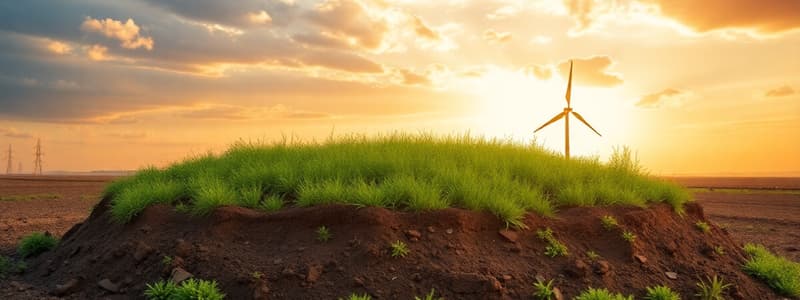Podcast
Questions and Answers
What is the present concentration of CO2 in our atmosphere?
What is the present concentration of CO2 in our atmosphere?
- 423 parts per million
- 560 parts per million
- 417 parts per thousand (correct)
- 280 parts per thousand
- 360 parts per million
There is widespread agreement that to minimize the amount of catastrophic damage due to climate change, the total amount of warming of the Earth's surface since the onset of the Industrial Revolution must be kept to ≤1.5°C. Given current trends in fossil fuels burning and energy policies of industrialized countries, what is the more likely amount of total global warming that will occur in this century?
There is widespread agreement that to minimize the amount of catastrophic damage due to climate change, the total amount of warming of the Earth's surface since the onset of the Industrial Revolution must be kept to ≤1.5°C. Given current trends in fossil fuels burning and energy policies of industrialized countries, what is the more likely amount of total global warming that will occur in this century?
- 4°C or higher as we are on the 'business as usual' emissions track
- between 3.0 and 4.0°C
- between 2.0 and 3.0°C (correct)
- between 1.5 and 2.0°C
- This is a trick question
Which one of the following statements best describes how the present-day concentration of CO2 in the atmosphere compares to the past before the accelerated use of fossil-fuels?
Which one of the following statements best describes how the present-day concentration of CO2 in the atmosphere compares to the past before the accelerated use of fossil-fuels?
- The CO2 concentration in today's atmosphere has started to decline since the Paris Agreement was made in 2015 reflecting that industrial countries have successfully initiated efforts to develop and use more green energy.
- The CO2 concentration in today's atmosphere has stayed near constant over the time since humans evolved.
- The CO2 concentration in today's atmosphere is higher than that of any time in the past 14 million years ago. (correct)
- The CO2 concentration in today's atmosphere is higher than the past few 100s of thousands of years but it is rising so slowly that it is negligibly impacting humans and other life on Earth.
- We don't know because it is not possible to reconstruct how atmospheric CO2 has varied in the very distant past.
Which one of the following is not a reason why extreme precipitation events have been increasing in both frequency and intensity over the past 3 decades?
Which one of the following is not a reason why extreme precipitation events have been increasing in both frequency and intensity over the past 3 decades?
That is, given the amount of CO2 that has been added to the atmosphere since the 1860s, higher temperatures would be expected. Which one of the following conditions has maintained the warming at this level and prevented a higher level of warming?
That is, given the amount of CO2 that has been added to the atmosphere since the 1860s, higher temperatures would be expected. Which one of the following conditions has maintained the warming at this level and prevented a higher level of warming?
Which one of the following best explains why climate change that is happening now appears to be unprecedented in Earth history when compared to past times of major climate change?
Which one of the following best explains why climate change that is happening now appears to be unprecedented in Earth history when compared to past times of major climate change?
Flashcards
Present CO2 concentration
Present CO2 concentration
The current amount of carbon dioxide in the Earth's atmosphere.
Safe global warming limit
Safe global warming limit
The maximum amount of warming the Earth's surface should experience to minimize climate change damage.
Likely global warming this century
Likely global warming this century
Estimated range of future global temperature increase based on current trends.
Past CO2 levels compared to present
Past CO2 levels compared to present
Signup and view all the flashcards
Extreme precipitation increase
Extreme precipitation increase
Signup and view all the flashcards
Warming absorbed by oceans
Warming absorbed by oceans
Signup and view all the flashcards
Unprecedented climate change rate
Unprecedented climate change rate
Signup and view all the flashcards
Wildfire activity increase cause
Wildfire activity increase cause
Signup and view all the flashcards
Atmosphere as a source/sink
Atmosphere as a source/sink
Signup and view all the flashcards
Earth system heat absorber
Earth system heat absorber
Signup and view all the flashcards
Greenhouse effect and global warming
Greenhouse effect and global warming
Signup and view all the flashcards
Negative feedback loop example
Negative feedback loop example
Signup and view all the flashcards
Jet Stream deflection
Jet Stream deflection
Signup and view all the flashcards
Atmospheric circulation initiation
Atmospheric circulation initiation
Signup and view all the flashcards
Atmospheric circulation driver
Atmospheric circulation driver
Signup and view all the flashcards
Jet Stream description
Jet Stream description
Signup and view all the flashcards
Jet Stream weakening cause
Jet Stream weakening cause
Signup and view all the flashcards
O2 and N2 absorption
O2 and N2 absorption
Signup and view all the flashcards
Marine deserts in ocean
Marine deserts in ocean
Signup and view all the flashcards
Impact of Greenland ice melt
Impact of Greenland ice melt
Signup and view all the flashcards
El Niño-Southern Oscillation (ENSO)
El Niño-Southern Oscillation (ENSO)
Signup and view all the flashcards
Importance of carbon cycling
Importance of carbon cycling
Signup and view all the flashcards
Evidence carbon cycle imbalance
Evidence carbon cycle imbalance
Signup and view all the flashcards
Natural CO2 reduction process
Natural CO2 reduction process
Signup and view all the flashcards
Common climate state throughout history
Common climate state throughout history
Signup and view all the flashcards
Formation of oil and natural gas link
Formation of oil and natural gas link
Signup and view all the flashcards
PETM significance in climate change
PETM significance in climate change
Signup and view all the flashcards
Current peak carbon emissions estimate
Current peak carbon emissions estimate
Signup and view all the flashcards
Climate warming threshold
Climate warming threshold
Signup and view all the flashcards
Rapid transition to alternative energy need
Rapid transition to alternative energy need
Signup and view all the flashcards
Negative emission technologies, examples.
Negative emission technologies, examples.
Signup and view all the flashcards
Fuel inefficiency and CO2 emission
Fuel inefficiency and CO2 emission
Signup and view all the flashcards
Enhanced mineral weathering
Enhanced mineral weathering
Signup and view all the flashcards
Ice core record lessons
Ice core record lessons
Signup and view all the flashcards
Urban development and climate
Urban development and climate
Signup and view all the flashcards
Impact of climate change on water in CA
Impact of climate change on water in CA
Signup and view all the flashcards
Climate solutions for water scarcity
Climate solutions for water scarcity
Signup and view all the flashcards
Current water solution limitations
Current water solution limitations
Signup and view all the flashcards
Study Notes
Quiz Questions
- Present CO2 concentration in the atmosphere: 417 parts per million
- Likely amount of total global warming this century: between 1.5°C and 2.0°C
- Present-day CO2 concentration compared to the past: higher than any time in the past 14 million years
Studying That Suits You
Use AI to generate personalized quizzes and flashcards to suit your learning preferences.




